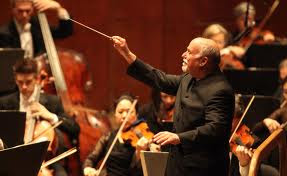Christoph von Dohnányi conducts the New York Philharmonic.
Christoph von Dohnányi has enjoyed a podium career spanning five decades, several recording contacts and a wide grasp of the standard repertory of the last three centuries. Yet, the most common criticism leveled against this German-born conductor is for his cerebral approach to music-making, a tendency to lead from the head, not the heart.
So it was a surprise to see that his second week of programming at the New York Philharmonic featured Tchaikovsky's Pathétique symphony, the composer's final composition which premiered nine days before his untimely death. The work was featured alongside Dvořák's Violin Concerto and (k)Ein Sommernachtstraum, a complex curtain-raiser by Russian composer Alfred Schnittke.
The Schnittke work is unusual in that its opening violin melody is played by the twelfth (and last) chair of the second violin section. This lone voice from extreme stage left was joined by flute, harpsichord and oboe in a pleasant theme that evoked the 18th century. Baroque pastiche quickly became parody, as Mr. Dohnányi brought in the full force of the orchestra.
Much to the dismay of some listeners, that opening theme shifted into a particularly strident minor key, lurching like a drunken circus band to blasts of brass and percussion. The twisted, calliope-like melodies were kept under tight control by the conductor. Eventually, the brief work returned to its basic opening: flute, harpsichord, and that lone, twelfth violin.
The German violinist Frank Peter Zimmermann is concluding his year-long residency at the Philharmonic this week. For his last set of concerts, he chose the Dvořák concerto, a piece that has traveled a hard road to earn a minor place in the repertory. The work was commisioned, and later rejected by violinist Joseph Joachim. The soloist disagreed with Dvořák's specification that the two opening movements should be played without a break,
Mr. Zimmermann has long been a champion of this particular concerto, which he first played at the age of 14. He demonstrated his commitment with the initial thematic statement. This led to long, rich melodic lines and potent chords, which seemed to move in flight as the soloist slid his fingers up the neck of his instrument.
The quick transition into the second movement allowed the soloist to shift into lyric mode, drawing out the rich melodies that make even the lesser works of Dvořák rewarding. The finale proved to be ingeniously constructed, built from the furiant and the dumka, two traditional Bohemian dances that happen to be in different meters. Mr. Dohnányi provided expert rhythmic accompaniment for Mr. Zimmermann. He sustained the listener's interest with gleeful technica wizardry, through the great length of the movement.
The program of the Pathétique symphony was hinted at by Tchaikovsky before his death. There was nothing mysterious, however, about Mr. Dohnányi's forthright interpretation. The passionate main theme, beloved by listeners, gave way to a potent first movement with a hair-raising account of the stormy middle section.
Mr. Dohnányi brought spare elegance to the second movement, a deceptive, courtly movement that seems like a waltz even though Tchaikovsky wrote it with five beats to the measure. The march was stirring and heroic, with powerful playing from the brass. They raged, stormed and finally locked step, bringing out the muscular, heroic qualities in Tchaikovsky's writing.
Then it was time for the finale: a slow, halting theme that drifts in an ocean of despair. The cellos and woodwinds wept in the opening pages. This bleak landscape became even more harsh under Mr. Dohnányi. Instead of whipping the musicians into a pathological frenzy, his cool style served to cast light on the composer's ultimate resignation in no uncertain terms.



























